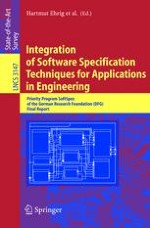2004 | Buch
Integration of Software Specification Techniques for Applications in Engineering
Priority Program SoftSpez of the German Research Foundation (DFG), Final Report
herausgegeben von: Hartmut Ehrig, Werner Damm, Jörg Desel, Martin Große-Rhode, Wolfgang Reif, Eckehard Schnieder, Engelbert Westkämper
Verlag: Springer Berlin Heidelberg
Buchreihe : Lecture Notes in Computer Science
Enthalten in: Professional Book Archive
